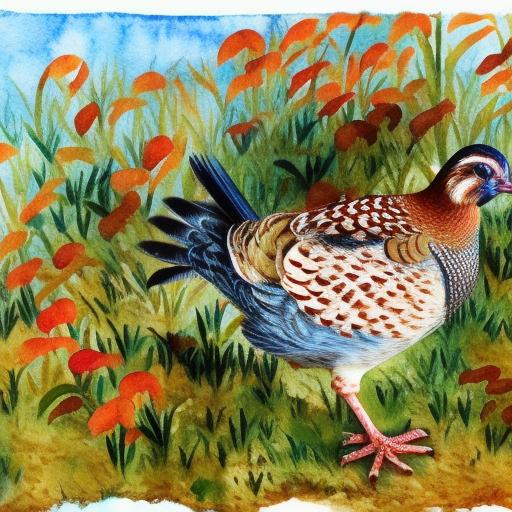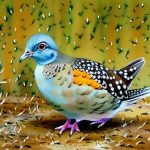Over breeding in quails is a common issue that many quail breeders face. Quails are known for their prolific breeding capabilities, and if not managed properly, over breeding can lead to a host of health issues and injuries for the birds. Over breeding occurs when quails are bred too frequently or without proper consideration for their health and well-being. This can lead to physical and behavioral signs of distress in the birds, as well as an increased risk of health complications. It is important for quail breeders to be aware of the signs of over breeding and take steps to prevent it in order to ensure the health and welfare of their birds.
Quails are popular birds for both commercial production and hobby farming, and their small size and low maintenance requirements make them an attractive option for many breeders. However, their prolific breeding capabilities can also be a challenge to manage. Over breeding can lead to a range of health issues and injuries for quails, which can impact their quality of life and productivity. It is important for quail breeders to be aware of the common injuries resulting from over breeding, as well as the behavioral and physical signs that indicate over breeding in order to provide appropriate care and prevent further complications for their birds.
Key Takeaways
- Over breeding in quails can lead to serious health issues and injuries
- Common injuries resulting from over breeding include feather loss, foot injuries, and reproductive problems
- Behavioral signs of over breeding in quails include aggression, restlessness, and excessive mating
- Health risks associated with over breeding include stress, exhaustion, and decreased immune function
- Prevent over breeding and injuries in quails by providing adequate space, balanced nutrition, and monitoring mating behavior
Common Injuries Resulting from Over Breeding
Over breeding in quails can lead to a range of common injuries that impact the birds’ health and well-being. One of the most common injuries resulting from over breeding is feather loss and damage. Quails that are bred too frequently may experience excessive mating behaviors, which can lead to feather plucking and damage. This can leave the birds vulnerable to injury and infection, as well as impact their ability to regulate their body temperature. Additionally, over breeding can lead to injuries such as cuts, bruises, and abrasions from aggressive mating behaviors, which can cause pain and discomfort for the birds.
Another common injury resulting from over breeding in quails is foot damage. Quails that are bred too frequently may experience excessive mating behaviors, which can lead to aggressive pecking and scratching. This can cause damage to the birds’ feet, including cuts, bruises, and abrasions, which can impact their ability to walk and move comfortably. Additionally, over breeding can lead to foot injuries such as bumblefoot, a condition characterized by swelling and infection of the foot pads, which can cause pain and discomfort for the birds. It is important for quail breeders to be aware of these common injuries resulting from over breeding in order to provide appropriate care and prevent further complications for their birds.
Behavioral and Physical Signs of Over Breeding in Quails
There are several behavioral and physical signs that indicate over breeding in quails. One common behavioral sign of over breeding is excessive mating behaviors. Quails that are bred too frequently may exhibit aggressive mating behaviors, including chasing, pecking, and mounting other birds. This can cause stress and discomfort for the birds, as well as lead to injuries such as feather loss and damage. Additionally, over breeding can lead to changes in the birds’ social dynamics, as aggressive mating behaviors can disrupt the hierarchy within the flock.
Another behavioral sign of over breeding in quails is increased aggression and agitation. Quails that are bred too frequently may become more aggressive and agitated, as they may feel stressed and overwhelmed by the constant mating behaviors. This can lead to fighting and aggression within the flock, as well as impact the birds’ overall well-being. In addition to behavioral signs, there are also physical signs of over breeding in quails. These may include feather loss and damage, foot injuries, weight loss, and decreased egg production. It is important for quail breeders to be aware of these behavioral and physical signs of over breeding in order to provide appropriate care and prevent further complications for their birds.
Health Risks and Complications Associated with Over Breeding
Over breeding in quails can lead to a range of health risks and complications that impact the birds’ overall well-being. One of the primary health risks associated with over breeding is stress. Quails that are bred too frequently may experience chronic stress due to aggressive mating behaviors, changes in social dynamics within the flock, and overall discomfort. Chronic stress can weaken the birds’ immune systems, making them more susceptible to infections and diseases. Additionally, stress can impact the birds’ reproductive health, leading to decreased egg production and fertility.
Another health risk associated with over breeding in quails is an increased risk of injury and infection. Quails that are bred too frequently may experience injuries such as feather loss and damage, foot injuries, cuts, bruises, and abrasions from aggressive mating behaviors. These injuries can leave the birds vulnerable to infection, as well as cause pain and discomfort. Additionally, over breeding can lead to reproductive health issues such as egg binding, a condition where an egg becomes stuck in the reproductive tract, which can be life-threatening for the bird if not addressed promptly. It is important for quail breeders to be aware of these health risks and complications associated with over breeding in order to provide appropriate care and prevent further harm to their birds.
Preventing Over Breeding and Injuries in Quails
There are several steps that quail breeders can take to prevent over breeding and injuries in their birds. One important step is to provide adequate space and resources for the birds. Overcrowding can lead to increased stress and aggression within the flock, as well as make it more difficult for the birds to escape aggressive mating behaviors. Providing ample space for the birds to move around freely, as well as access to food, water, and shelter, can help reduce the risk of over breeding and injuries.
Another important step in preventing over breeding and injuries in quails is to monitor the birds’ behavior and health regularly. By observing the birds closely, breeders can identify any signs of over breeding or distress early on and take appropriate action. This may include separating aggressive birds from the flock, providing additional nesting boxes or hiding spots for the birds to escape aggressive mating behaviors, or seeking veterinary care for injured or stressed birds. Additionally, implementing a breeding schedule that allows for adequate rest periods between mating cycles can help prevent over breeding and reduce the risk of injuries for the birds.
Treatment and Care for Injured Quails

In the event that a quail becomes injured as a result of over breeding, it is important for breeders to provide appropriate treatment and care to help the bird recover. One important step in treating injured quails is to provide a safe and comfortable environment for the bird to rest and heal. This may include separating the injured bird from the flock to reduce stress and aggression, as well as providing a quiet and warm space for the bird to recuperate. Additionally, providing access to food, water, and veterinary care as needed can help support the bird’s recovery.
Another important aspect of treating injured quails is to address any physical injuries or infections promptly. This may include cleaning and dressing wounds, providing pain relief medication as needed, and monitoring the bird closely for any signs of infection or complications. Additionally, providing supportive care such as gentle handling, regular monitoring, and a balanced diet can help promote healing and recovery for injured quails. It is important for quail breeders to be proactive in seeking veterinary care for injured birds when needed in order to ensure their health and well-being.
Conclusion and Recommendations for Quail Breeders
In conclusion, over breeding in quails can lead to a range of health issues and injuries that impact the birds’ overall well-being. It is important for quail breeders to be aware of the signs of over breeding, common injuries resulting from over breeding, behavioral and physical signs of distress in their birds, as well as health risks associated with over breeding in order to provide appropriate care and prevent further harm to their birds. By taking steps to prevent over breeding through adequate space and resources, monitoring the birds’ behavior and health regularly, implementing a breeding schedule that allows for adequate rest periods between mating cycles, quail breeders can help ensure the health and welfare of their birds.
Additionally, in the event that a quail becomes injured as a result of over breeding, it is important for breeders to provide appropriate treatment and care to help the bird recover. This may include providing a safe and comfortable environment for the bird to rest and heal, addressing any physical injuries or infections promptly, providing supportive care such as gentle handling, regular monitoring, and a balanced diet, as well as seeking veterinary care when needed. By being proactive in preventing over breeding and providing appropriate care for injured birds, quail breeders can help ensure the health and welfare of their flocks.
If you’re concerned about quail injuries from over breeding, it’s important to ensure that your coop is equipped with the right heating system to maintain a comfortable environment for your birds. In a related article on PoultryWizard, “Heater for a Chicken Coop,” you can find valuable information on choosing the right heater for your chicken coop to prevent health issues and ensure the well-being of your poultry. Proper heating can help mitigate the risks associated with over breeding and create a healthier living environment for your quail. (source)
FAQs
What are quail injuries from over breeding?
Quail injuries from over breeding refer to the physical and physiological harm that can occur in quail as a result of excessive breeding practices. This can include issues such as leg deformities, weakened immune systems, and reproductive problems.
What are some common injuries seen in quail from over breeding?
Common injuries seen in quail from over breeding include leg deformities, such as splayed legs and crooked toes, as well as reproductive issues, such as egg binding and prolapse. Additionally, over breeding can lead to weakened immune systems and overall poor health in quail.
How can over breeding impact the welfare of quail?
Over breeding can have a significant negative impact on the welfare of quail. It can lead to chronic pain and discomfort due to physical deformities, as well as increased susceptibility to disease and reduced quality of life.
What can be done to prevent quail injuries from over breeding?
To prevent quail injuries from over breeding, breeders should practice responsible breeding techniques, including avoiding excessive inbreeding and allowing for adequate rest periods between breeding cycles. Additionally, providing a balanced diet and proper housing conditions can help support the overall health and welfare of quail.
Meet Walter, the feathered-friend fanatic of Florida! Nestled in the sunshine state, Walter struts through life with his feathered companions, clucking his way to happiness. With a coop that’s fancier than a five-star hotel, he’s the Don Juan of the chicken world. When he’s not teaching his hens to do the cha-cha, you’ll find him in a heated debate with his prized rooster, Sir Clucks-a-Lot. Walter’s poultry passion is no yolk; he’s the sunny-side-up guy you never knew you needed in your flock of friends!







